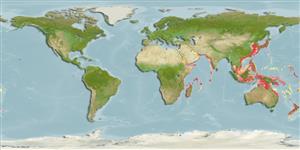Environment: milieu / climate zone / depth range / distribution range
Écologie
marin démersal; profondeur 46 - 100 m (Ref. 11441). Tropical; 42°N - 22°S, 55°E - 141°E
Indo-West Pacific: Funka Bay of Hokkaido to the South China Sea and farther south (Ref. 559). Recorded from Oman (Ref. 11441).
Length at first maturity / Taille / Poids / Âge
Maturity: Lm 6.8, range 7 - 7 cm
Max length : 14.8 cm TL mâle / non sexé; (Ref. 125279); poids max. publié: 15.20 g (Ref. 112063)
Épines dorsales (Total): 8; Rayons mous dorsaux (Total): 9; Épines anales 2; Rayons mous anaux: 8. Ten to 12 brown bands on sides of body. Number and width of these bands varies with habitat. Body shape and coloration closely resembles A. ellioti, but distinguished by not having luminous organ. Attains 8 cm TL.
Abundant on sandy and muddy bottoms from coastal inlets to deeper waters (Also Ref. 11230). Breeding season is from July to September. Males brood eggs in the mouth. Made into fish paste (Ref. 559 and 637).
Mouthbrooders (Ref. 240). Distinct pairing during courtship and spawning (Ref. 205).
Masuda, H., K. Amaoka, C. Araga, T. Uyeno and T. Yoshino, 1984. The fishes of the Japanese Archipelago. Vol. 1. Tokai University Press, Tokyo, Japan. 437 p. (text). (Ref. 559)
Statut dans la liste rouge de l'IUCN (Ref. 130435)
Menace pour l'homme
Harmless
Utilisations par l'homme
Plus d'informations
RéférencesAquacultureProfil d'aquacultureSouchesGénétiqueElectrophoresesHéritabilitéPathologiesTraitementNutrientsMass conversion
CollaborateursImagesStamps, Coins Misc.SonsCiguateraVitesseType de nageSurface branchialeOtolithesCerveauxVision
Outils
Articles particuliers
Télécharger en XML
Sources Internet
Estimates based on models
Preferred temperature (Ref.
123201): 17.3 - 28.1, mean 26.4 °C (based on 345 cells).
Phylogenetic diversity index (Ref.
82804): PD
50 = 0.5000 [Uniqueness, from 0.5 = low to 2.0 = high].
Bayesian length-weight: a=0.01413 (0.00837 - 0.02384), b=3.18 (3.03 - 3.33), in cm total length, based on LWR estimates for this species & (Sub)family-body (Ref.
93245).
Niveau trophique (Ref.
69278): 3.7 ±0.5 se; based on diet studies.
Résilience (Ref.
120179): Haut, temps minimum de doublement de population inférieur à 15 mois (tm=1; K=0.37-1.12; Tmax=3-5).
Fishing Vulnerability (Ref.
59153): Low vulnerability (12 of 100).
